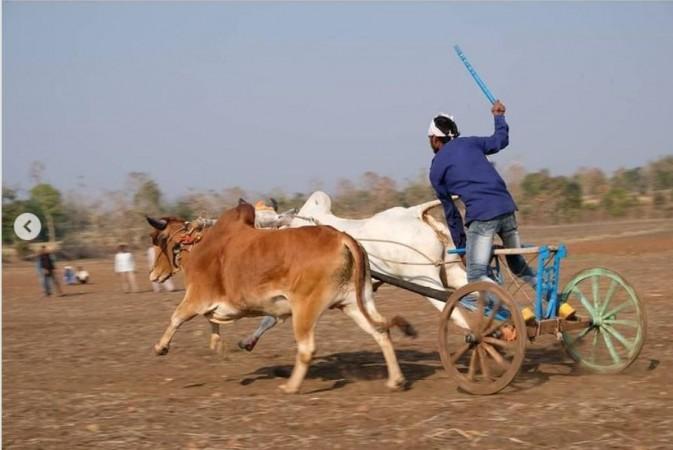It was around the 14th century when in northeastern Spain, the tradition of running in front of the bulls began. Titled 'encierro of Pamplona', men found a certain rush and adrenaline while running for their life in front of fiercely running bulls.
Continents away, in Asia, primarily India, rural villages found means of transportation in bullock carts around the 18th-19th century. Bulls that were earlier used only for breeding purposes, began to ferry luggage, farm produce, and people from one place to another.
But the raging nature of bulls had to be used elsewhere too, and therefore, bullock cart races were introduced. Soon, owning and maintaining bulls became a matter of pride, and those who could afford it got onto training the bulls to participate in cart races.

Popularly known as 'Shankarpat' in Maharashtra, 'Kambala' in Karnataka (buffalo race), 'Rekla' in Tamil Nadu, 'baulda di daud' in Punjab, bullock cart race is also known to have been practised in Madhya Pradesh, Andhra Pradesh, and Telangana. Until some years ago, bulls were known to be bred especially to take part in such races, a symbol of prestige for their owners in rural areas. These race-worthy bulls were taken care of the whole year and trained especially to run at such events that proved to be amusement for onlookers.
An article in People' archive of rural India described the bullock cart races at a carnival in Chandrapur district, Maharashtra adding that due to lack of space, the race takes place in a time trial format where each participant is timed individually.
"It's different from other racing scenes as the spectators are everywhere, even in the middle of the tracks, some of them crossing the ruts with their backs to onrushing bullocks in the middle of a race. But there were no mishaps. The audience yells its lungs out to alert the miscreant who leaps out of the way like a startled stuntman. The cart racer does not slow down a whit. Though there are groups of youth dangerously close to the tracks, ostensibly to cheer their heroes on. The less boisterous sections of the audience maintain a safe distance, some perched on top of regular carts piled high with straw. That's the dress circle and balcony. Still, others potter through the carnival, buying goods but breaking off when the roar of a race beckons them."
In Tamil Nadu, this year the Rekla club and MGR Youth Wing organized a bull race in January as part of its Pongal celebrations. As reported by the Times of India, thousands of spectators enjoyed the rekla race held on Codissia road in Coimbatore with more than 500 bullock carts brought from various parts of the state.
In 2019, The Quint reported on another rekla event organized by students of an engineering college which saw as many as 1,000 bulls from states of TN and Kerala. The report stated, "The bulls are trained for many years before they are finally ready to participate. Most of these animals have been trained from the age of 4 years. They have been made to run, plough, and swim to strengthen their muscles." What's in for the participants and winners—the lure of gold and a prestige tag.
Wild Films India has documented some of these bull races has made available some of the footage on its YouTube page. Footage from the early 90s shows a race scene from Pune where yellow-colored bulls in pairs tied to another pair of bulls at the back run on the track with a cart trailing behind. Hundreds of spectators lined up on both sides of the road watching the animals struggle to the finishing line.
In Southern Karnataka, during Kambala, an annual cultural festival, the farming community comes together to race a pair of buffalos through slushy paddy fields. Unlike other races, there is no cart here, but a jockey who runs along with the racy animals.
Legal boundaries
In 2014, this traditional cultural sport celebrated across the nation was downed by animal right activists on the ground of cruelty to animals and banned by the top government stating that "use of bulls in such events severely harmed the animals and constituted an offence under the Prevention of Cruelty to the Animals Act."
However, in 2017 Maharashtra government upon lifting the ban amended the Prevention of Cruelty to Animals Act, 1960, to legalize bullock-cart racing. As per the amendment incorporated in the Prevention of Cruelty to Animals Act, those found guilty for pain or suffering to the animal will also have to face with fine up to Rs 5 lakh or maximum punishment up to three years in jail," it stated.
In July 2017, the then president Pranab Mukherjee gave his assent to the Prevention of Cruelty to Animals (Karnataka Amendment) Ordinance 2017 clearing the way for resuming Kambala, which was stopped by the Karnataka high court in 2016, referring to the 2014 judgment of the Supreme Court.

States have the power to enact laws on this subject as long as they do not violate the centre laws. The Prevention of Cruelty to Animals Act, 1960 (PCA) prohibits the use of animals for entertainment or display. However, animals considered "performance animals," are exempt from these protections, leaving these animals at the mercy of their owners.

















